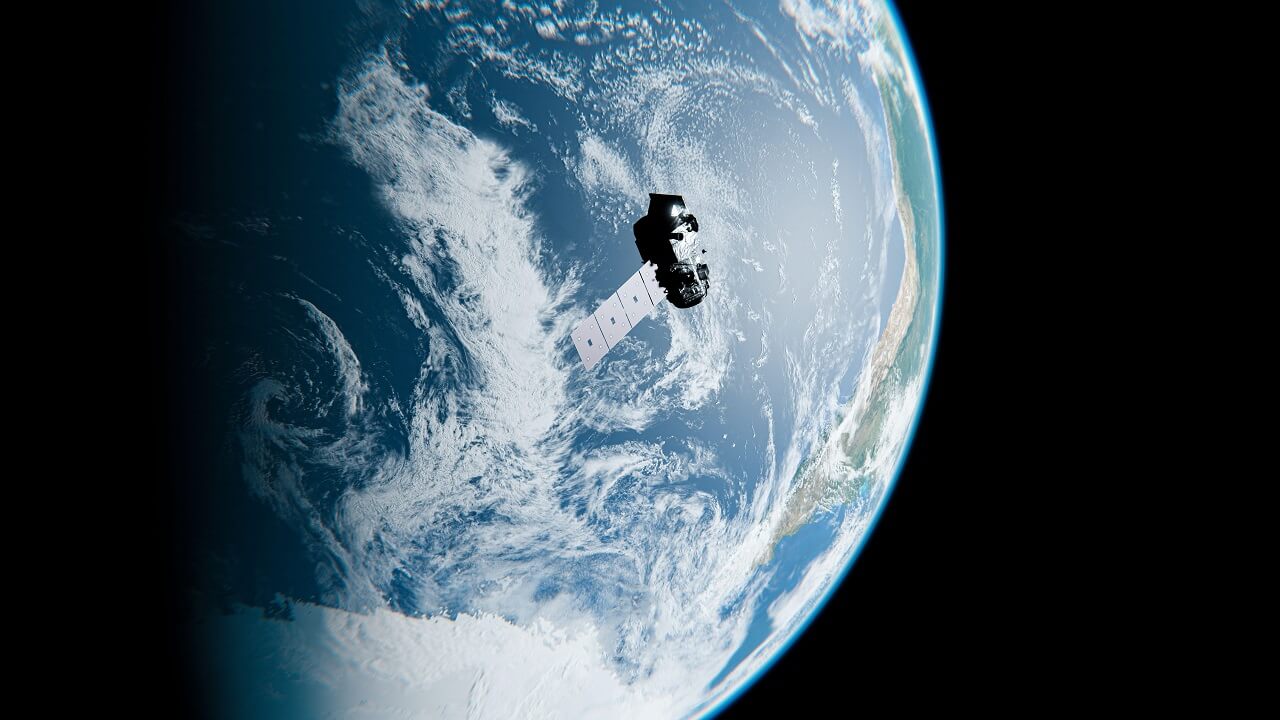Will Data Centers in Orbit Launch a New Phase of Sustainability?Will Data Centers in Orbit Launch a New Phase of Sustainability?
A new study funded by the European Commission finds promising results for space data center feasibility.

As data center demand continues to boom, an answer to sustainability needs might be found in Earth’s orbit.
Power consumption in the US market is expected to increase from 17 gigawatts (GW) in 2022 to 35 GW by 2030, according to McKinsey & Company. While companies race to keep up with that demand, building more data centers to support cloud operations and increasingly AI models, it is becoming clear how hungry the industry is for limited resources. Data centers demand power, water, land, and critical raw materials.
While hyperscalers and industry stakeholders increasingly set and work toward more terrestrial sustainable practices, there is also the more real than ever possibility of looking skyward for a solution.
The space industry as a new frontier of innovation that offers a vast, largely untapped environment full of business opportunities for tech firms. Lunar data centers are one possibility. Now, a new study led by Thales Alenia Space, a space systems manufacturer based in France, and funded by the European Commission, found promising results for the technological feasibility and environmental feasibility of launching data centers into space.
InformationWeek spoke to an expert with Thales Alenia Space and leaders in the data center industry about challenges that data centers face on Earth and the possibility of launching them into space.
Terrestrial Troubles
Why do we need to look to the stars for data centers in the first place?
The energy demands and environmental impact of data centers are well-documented. Data centers strain electrical grids and contribute to global CO2 emissions. They consume millions of gallons of water, with many relying on scarce water supplies. Data centers need land. When located near populated areas, they can disrupt the lives of the people living there with noise pollution. And the data center industry’s need for critical raw materials only grows.
The rush to adopt AI intensifies data center demand and the accompanying capacity and environmental strains.
“Even before GenAI joined the equation, we began to have data center capacity constraints. With the advent of AI, those constraints are amplified, and we now see data center operators facing a two- to three-year lead time in building a data center,” Joe Minarik, COO at data center solutions company DataBank, tells InformationWeek in an email interview.
These challenges are not being ignored on Earth.
“Many leading cloud providers, they have aggressive targets and goals to become carbon neutral, to reduce their emissions, to leverage solar power to offset their carbon footprint,” Yuri Gubin, chief innovation officer at DataArt, an enterprise software development company, tells InformationWeek.
In addition to solar and wind power, nuclear power is being investigated. Bill Gates put $1 billion into a nuclear power plant being built in Wyoming. Hyperscalers such as Amazon, Microsoft, and Google are showing interest in nuclear and geothermal power, according to GreenBiz.
The data center industry is also adopting more efficient water usage approaches. “Most cooling systems are now closed-loop where water is recycled and reused within the facility, requiring little to no additional water,” according to Minarik.
Remote environments like deserts and oceans are being explored for data center construction, although these options come with their own questions about building in delicate ecosystems.
Efforts are being made to create “circular centers,” reducing hardware waste by reusing resources.
The Upside Among the Stars
Space offers an appealing solution for many of the problems that plague terrestrial data centers. Space-based data centers could use solar arrays to draw power from the sun, alleviating the burden on electrical grids here on Earth. They would not require water for cooling. They would not take up land, disturb people or wildlife.
Additionally, natural disasters that can damage or wipe out data centers on Earth -- earthquakes, wildfires, floods, tsunamis -- are a non-issue in space.
Feasibility in Space
While the upsides of data centers in space are easy to imagine, what will it take to make them a reality? The Advanced Space Cloud for European Net zero emission and Data sovereignty (ASCEND) study set out to answer questions about space data centers technical feasibility and their environmental benefits.
The study is funded by the European Commission as part of the Horizon Europe, a scientific research program. Thales Alenia Space led the study with a consortium of 11 partners, including research organizations and industrial companies from five European countries.
Thales Alenia Space announced the results of the 16-month study at the end of June. The study focuses on the need for the development of an eco-designed and reusable launcher capable of handling heavy payloads with significantly reduced emissions. This launcher would be able to send the necessary components, including large solar arrays, to space where they would be assembled and deployed in orbit.
The ASCEND study found that development of such a launcher is feasible, as is the assembly of modular space infrastructures with robotics.
“In the short term, we need some investment. We need some new development, but we are not relying on new [technologies] that are not known by today,” Damien Dumestier, who heads the ASCEND study at Thales Alenia Space, explains. “We are relying on existing technology or in-development technology.”
Technology such as perovskite solar cells and thermal regulation systems could have potential applications for space data centers.
Hurdles to Overcome
While this vision is feasible, there are hurdles to overcome before we get there. For one, the cost of developing the necessary launcher will be significant. According to Space Impulse, a space industry market intelligence provider, the cost to launch orbital rockets varies dramatically by intended purpose. A small satellite launcher can cost $7.5 million while Space X’s Falcon 9 rocket can cost $67 million per launch.
If data centers in space are to become large scale, viable options, the ability to manufacture the necessary components, not to mention multiple launchers, will be an expensive undertaking.
“There's a technological advancement that needs to happen, being able to go ship construction platforms and robotics to go build these facilities,” Jason Carolan, chief innovation officer at Flexential, a hybrid IT infrastructure provider, points out.
Once the components of a data center are launched and assembled, how will they endure the harsh conditions of space? Unlike terrestrial data centers, cooling will not be necessary, but there are other factors, like radiation and extremely cold temperatures, to consider.
“We need to be able to manufacture and to test a lot of components that will be resistant to a specific environment,” says Dumestier.
If these components do not withstand the space environment over time, there is a risk of increased debris if the technology fails. “What if it starts breaking apart? What are they consequences of all of [this] debris flying around in … space?” Gubin asks.
Concerns About Light Pollution
Gubin also raises concerns over light pollution. “If we have thousands and thousands of satellites in space, it will change irreversibly … the way how our children, grandchildren will see the night sky,” he says.
Even if space data centers operate perfectly with 100% uptime and resilience to the environment in space, what about latency? “You cannot expect it to be micro- or milli- or nanosecond latency,” Gubin points out.
But that doesn’t mean there won’t be players eager to shoulder the cost and the challenges. Space data centers could be a lucrative endeavor. The ASCEND study found that this initiative could result in a return on investment in the billions of euros between now and 2050.
What could happen between now and then?
“I think we'll continue to see pilots, proof of concepts over the course of the next five to 10 years,” says Carolan. ASCEND will be among the players aiming to manufacture a proof-of-concept within the next few years.
That proof-of-concept would be a “ … space data center large enough to provide some relevant capability to perform some processing, storage and so on but smaller than the final one that we want to deploy because the final one that we want to deploy needs need a big launcher that it is not currently available on the market,” Dumestier shares.
ASCEND has plans to deploy one GW before 2050. Between now and then, the companies involved in the consortium will continue to work on demonstrating the feasibility of space data centers and ramping up the manufacture of the necessary technology. This project supports the EU Green Deal, which has set the ambitious goal of achieving net-zero greenhouse gas emissions in Europe by 2050.
Lessons on What Works, What Does Not
We have decades to go before we hit 2050 and those years will likely hold many lessons on what works and does not as we look to bring data centers to space.
“We can try deploying something and see how it works, how it performs, what are the lessons learned. But I think that we are decades away from actually having enterprise-level facilities flying in space,” says Gubin.
The European Commission and the partners involved in the ASCEND study are far from the only interested parties, public or private, that want to see space-based data centers. That opens the door to both competition and potential collaboration.
Space may or may not be infinite, but there will still be intense competition to leverage this relatively untapped environment for data centers and other business ventures. The modern space race raises questions about who will get there first at scale and who will make the rules.
“Sovereignty is an interesting angle on this because the moon, in particular, and space kind of [have] a law structure that is fairly open,” says Carolan.
While Thales Alenia Space will work toward translating the results of the ASCEND study into reality, Dumestier sees potential collaboration as a positive.
“It is such an ambitious project that I would say that contribution from any country will be welcome,” he shares.
If space data centers are the future, they could cause a significant paradigm shift in the industry. Perhaps terrestrial data centers will be phased out, but there are still years of technological development ahead before that hypothetical future is realized.
“We still have work to do, but it is very encouraging and very promising,” says Dumestier.
About the Author
You May Also Like






